| Article ID | Journal | Published Year | Pages | File Type |
|---|---|---|---|---|
| 4988620 | Journal of Membrane Science | 2017 | 30 Pages |
Abstract
In order to integrate the advantages of polyamide thin film composite (TFC) nanofiltration (NF) membranes and that of polyester TFC NF membranes, a novel polyesteramide (PEA) TFC NF membrane was prepared by interfacial polymerization between serinol and trimesoyl chloride (TMC) and catalyzed by 4-dimethylaminopyridine (DMAP) on a flat-sheet polyethersulfone (PES) substrate membrane. The membrane performance was maximized by optimizing different preparation parameters. The reaction process was divided into four basic patterns. X-ray photoelectron spectroscopy (XPS) and infrared spectroscopy confirmed the membrane had a partially cross-linked active layer that contained ester bonds, amide bonds and residual hydroxyl groups. Morphology analysis showed the surface of the PEA-TFC-NF membrane was grainy, which was different from the typical polyamide membranes. The contact angle and zeta potential measurements confirmed the PEA-TFC-NF membrane was highly hydrophilic and negatively charged across the entire pH range tested. The optimized PEA-TFC-NF membrane had a MWCO of 474 Da and water permeability of 6.0 L mâ2 hâ1 barâ1 at 0.5 MPa and 25 °C. The membrane salt rejections followed the order of Na2SO4 > MgSO4 > NaCl > MgCl2, which were 96.27%, 83.92%, 58.68% and 28.76%, respectively. Moreover, the PEA-TFC-NF membrane displayed good antifouling ability.
Related Topics
Physical Sciences and Engineering
Chemical Engineering
Filtration and Separation
Authors
Ruijun Zhang, Shuili Yu, Wenxin Shi, Wei Wang, Xiaoying Wang, Zhiqiang Zhang, Li Li, Bing Zhang, Xian Bao,
